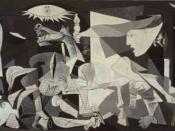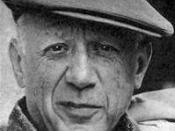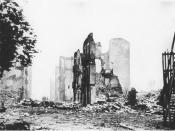Pablo Picasso, a famous artist in the 18th and 19th century, has fantastically generated numerous unusual though unique and interesting artworks portraying many of his personal attitudes. Displaying his lines of movement, choice of colour and application of style on media, 'Guernica' was produced in 1937 after several changes in the composition. 'The value and authenticity of 'Guernica' is achieved not by means of historical accuracy or a simple re-telling of what happened, but through the unceasing timelessness of suffering." By means of analysing and separating each element of his artwork, a clearer and more comprehendible aspect towards the veracity of this quote is able to be determined. Picasso was inspired during the Spanish Civil War to depict his thoughts on it, however, the components of his artwork do not specifically symbolise the bombing of Basque town, different to the way artist had portrayed war. The techniques used and their associated meanings are discussed to demonstrate the impact not only on the artwork itself but the effect it has left the audience and the composer.
On a Monday in Guernica, April 27th 1937, the lives of thousands instantly diminished after Hitler's forces dumped one hundred thousand pounds of high-explosive and inflammatory bombs on the village, slowly and systematically pounding it to rubble. Seventy percent of the town was destroyed. Sixteen hundred civilians - one third of the population - were killed or wounded. As the news spread rapidly, Nationalists immediately denied any involvement, as did the Germans.


